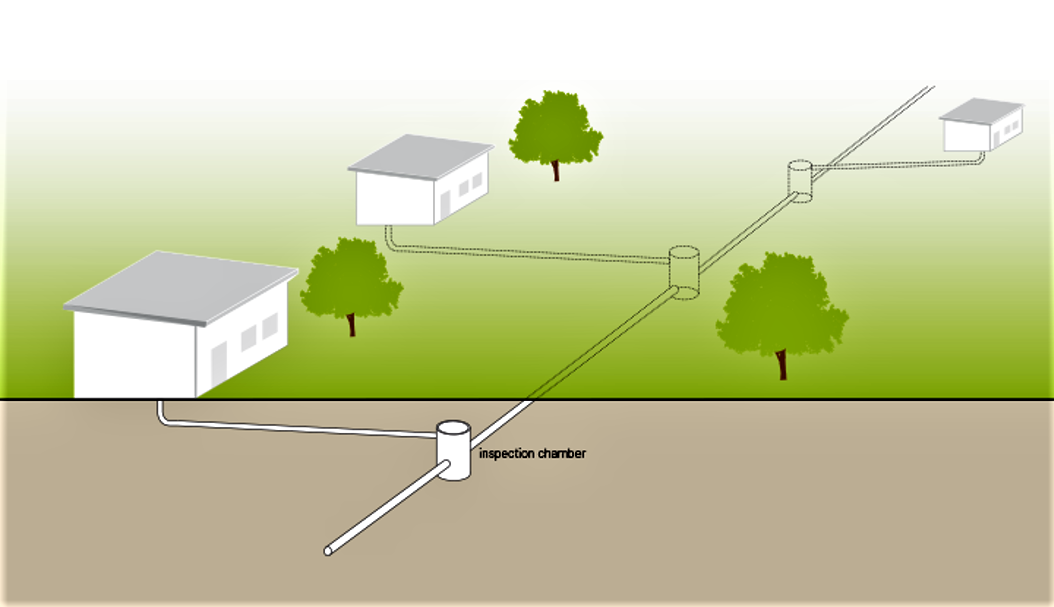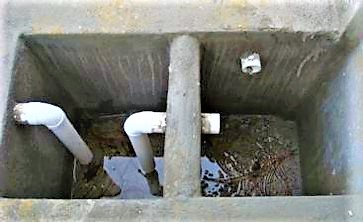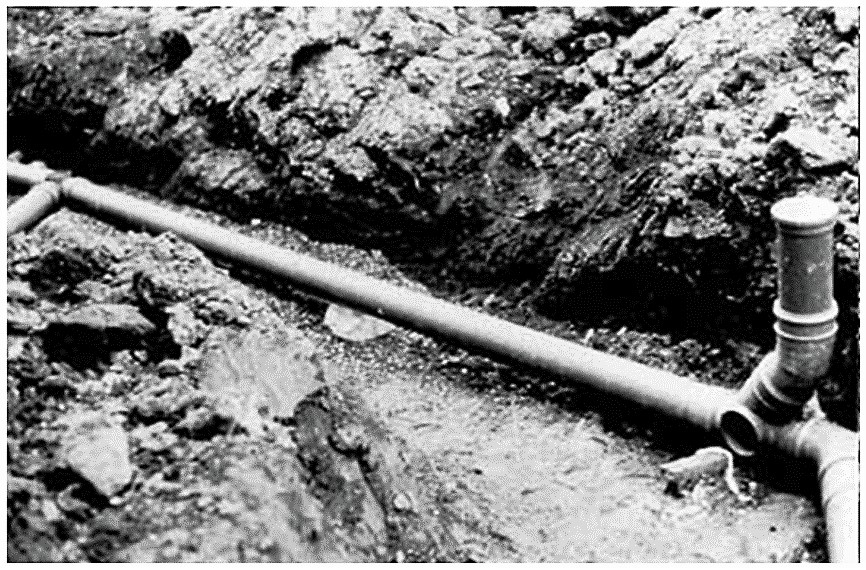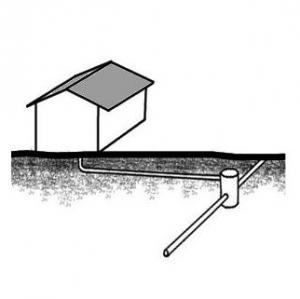Executive Summary
A simplified sewer describes a sewerage network that is constructed using smaller diameter pipes laid at a shallower depth and at a flatter gradient than conventional sewers. The simplified sewer allows for a more flexible design at lower costs similar to solids-free sewers . Condominial sewers are constructed like simplified sewers but designed for the scale of a housing area involving end-users in planning and implementation. Simplified sewers are also advantageous in rocky areas or where the groundwater table is high. Simplified sewers can be built and repaired with locally available materials. However, expert design and construction supervision is essential and repairs and removal of blockages may be required more frequently than for a conventional gravity sewer. Effluent and sludge (from interceptors) requires secondary treatment and/or appropriate discharge.
| In | Out |
|---|---|
| Blackwater, Greywater, Brownwater, Urine or Yellowwater, Non-biodegradable Wastewater |
Blackwater, Non-biodegradable Wastewater |
Introduction
The high rate of urbanisation creates high-density low-income areas in many developing countries. In this context, simplified sewerage is technically and institutionally feasible, economically appropriate and financially an affordable sanitation option (MARA 1996). Wastewater is collected, pre-settled and then transported to the main network or directly to a semi-centralised secondary treatment system such as constructed wetlands (free-surface, horizontal or vertical), or waste stabilisation ponds). The sludge from interceptor tanks (and other pre-settling units) needs also secondary treatment (see also settling and thickening, drying beds, non-planted filters, mechanical dewatering, composting, further anaerobic digestion at large scale), after emptying (see human powered or motorised emptying and transport).

Because simplified sewers are laid on or around the property of the users, higher connection rates can be achieved, fewer and shorter pipes can be used and less excavation is required as the pipes will not be subject to heavy traffic loads. However, this type of conveyance technology requires careful negotiation between stakeholders (see stakeholder analysis), since design and maintenance must be jointly coordinated.
Conceptually, simplified sewerage is the same as Conventional Gravity Sewerage, but without unnecessarily conservative design standards and with design features that are better adapted to the local situation. The pipes are usually laid within the property boundaries, through either the back or front yards, rather than beneath the central road, allowing for fewer and shorter pipes. Because simplified sewers are typically installed within the condominium, they are often referred to as condominial sewers. The pipes can also be routed in access ways, which are too narrow for heavy traffic, or underneath pavements (sidewalks). Since simplified sewers are installed where they are not subjected to heavy traffic loads, they can be laid at a shallow depth and little excavation is required.
Design Considerations
In contrast to conventional sewers that are designed to ensure a minimum self-cleansing velocity, the design of simplified sewers is based on a minimum tractive tension of 1 N/m2 (1 Pa) at peak flow. The minimum peak flow should be 1.5 L/s and a minimum sewer diameter of 100 mm is required. A gradient of 0.5% is usually sufficient. For example, a 100 mm sewer laid at a gradient of 1 m in 200 m will serve around 2,800 users with a wastewater flow of 60 L/person/day.

PVC pipes are recommended to use. The depth at which they should be laid depends mainly on the amount of traffic. Below sidewalks, covers of 40 to 65 cm are typical. The simplified design can also be applied to sewer mains; they can also be laid at a shallow depth, provided that they are placed away from traffic.
Expensive manholes are normally not needed. At each junction or change in direction, simple inspection chambers (or cleanouts) which can also take the function of interceptor tanks are sufficient to prevent solids to enter the main system . Inspection boxes are also used at each house connection. Where kitchen greywater contains an appreciable amount of oil and grease, the installation of grease traps (see Pre-Treatment Technologies) or a settling unit (e.g. imhoff tank, septic tank, biogas settler is recommended to prevent clogging.
Greywater should be discharged into the sewer to ensure adequate hydraulic loading, but stormwater connections should be discouraged in order to prevent overload during heavy rains . However, in practice it is difficult to exclude all stormwater flows, especially where there is no alternative for storm drainage. The design of the sewers (and treatment plant) should, therefore, take into account the extra flow that may result from stormwater inflow.

Blocks of community-based simplified sewers are connected to an existing conventional gravity sewer or routed to a simplified sewer main constructed with pipes of a larger diameter. Oftentimes, the community will purchase, and connect to, a single legal connection to the main sewer; the combined effluent of the condominal sewer network then flows into the main sewer line or directly to a semi-centralised secondary treatment system.
Costs Considerations
(Adapted from MARA 1996)
The costs of simplified sewerage systems are low (50 to 80 % less expensive than conventional gravity sewerage), sometimes even lower than those of onsite sanitation. This is because simplified sewerage (especially condominal sewerage), in common with settled sewerage (see also solids-free sewers), uses shallow excavation depths, small diameter pipe and simple inspection units (in place of large manholes). Additionally, the sewer gradients of simplified sewerage are much flatter than those of conventional systems requiring smaller excavation for laying the network. Also, the costs for emptying interceptors and inspection chambers or, if existing, the grease traps or pre-settling must be considered.
Health Aspects/Acceptance
If well constructed and maintained, sewers are a safe and hygienic means of transporting wastewater. Users must be well trained regarding the health risks associated with removing blockages and maintaining inspection chambers.
Operation & Maintenance
Trained and responsible users are essential to ensure that the flow is undisturbed and to avoid clogging by trash and other solids. Occasional flushing of the pipes is recommended to insure against blockages. Blockages can usually be removed by opening the cleanouts and forcing a rigid wire through the pipe. Inspection chambers and interceptor tanks must be periodically emptied to prevent grit overflowing into the system. The system should also be checked by the authority responsible for the main sewer network, because the system will be at risk if solids can enter. The sludge in the interceptor tank and pre-settling units also needs to be removed regularly and appropriately treated (see above). The operation of the system depends on clearly defined responsibilities between the sewerage authority and the community. Ideally, households will be responsible for the maintenance of pre-treatment units and the condominial part of the sewer. However, in practice this may not be feasible because users may not detect problems before they become severe and costly to repair. Alternatively, a private contractor or users committee can be hired to do the maintenance.

Besides checking the interceptor tanks and inspection chambers, the main organisational activity of the authority is to provide desludging services. The principal problems related to desludging revolve around responsibility. Normally, this lies with the property owners, since the interceptor tanks are on their property. But residents who are not owners have no incentive to desludge the tanks regularly, since this costs money and is inconvenient, and the overflowing sludge in the sewerage system does not directly affect them (even though it will affect the communal sewerage system downstream). If the sewer system is to work effectively, responsibility for tank desludging must fall on the organisation responsible for communal sewer maintenance. This organisation should also bear responsibility for treating effluents from the sewers.
Simplified sewers can be installed in almost all types of settlements and are especially appropriate for dense urban areas where space for onsite technologies is limited or in remote areas instead of a full-scale sewer system . They should be considered as an option where there is a sufficient population density (about 150 people per hectare) and a reliable water supply (at least 60 L/person/day).
Where the ground is rocky or the groundwater table high, excavation may be difficult. Under these circumstances, the cost of installing sewers is significantly higher than in favourable conditions. Regardless, simplified sewerage is between 20 and 50% less expensive than conventional sewerage.
To prevent clogging and maintain the sewers, good pre-treatment is required. It is recommended that the scum from greywater, heavy solids and garbage is removed from the wastewater prior to entering the sewer (TILLEY et al. 2008).
Simplified (as well as small-bore sewers can be an alternative in areas where individual on-site sanitation (e.g. septic tanks, leaching fields/soak pits) are not appropriate due to soil conditions (see also solids-free sewer system, BRIKKE and BREDERO 2003).
Simplified Sewerage: Design Guidelines
Design guidelines for manual calculations of simplified sewers.
BAKALIAN, A. WRIGHT, A. OTIS, R. AZEVEDO NETTO, J. (1994): Simplified Sewerage: Design Guidelines. Washington, D.C.: United Nations Development Programme (UNDP), World Bank Water and Sanitation Program URL [Accessed: 22.07.2014]Linking Technology Choice with Operation and Maintenance in the context of community water supply and sanitation. A reference Document for Planners and Project Staff
This document is addressed to planners and staff of water supply and sanitation projects on household and community level. The reader is guided through the main steps of informed choices regarding the main proven technologies for water supply, purification and water treatment at household and community level. Each technology is described in a small factsheet, regarding its functioning, actors and their roles, the main operation and maintenance (O&M) requirements and problems, which can occur.
BRIKKE, F. BREDERO, M. (2003): Linking Technology Choice with Operation and Maintenance in the context of community water supply and sanitation. A reference Document for Planners and Project Staff. Geneva: World Health Organization and IRC Water and Sanitation Centre URL [Accessed: 03.06.2018] PDFSanitation Systems and Technologies. Lecture Notes
Lecture notes on technical and non-technical aspects of sanitation systems in developing countries.
EAWAG/SANDEC (2008): Sanitation Systems and Technologies. Lecture Notes . (= Sandec Training Tool 1.0, Module 4 ). Duebendorf: Swiss Federal Institute of Aquatic Science (EAWAG), Department of Water and Sanitation in Developing Countries (SANDEC)Sanitation for All in Periurban Areas? Only If We Use Simplified Sewerage
PC Based Simplified Sewer Design
The purpose of this document is to disseminate the simplified sewer technology more widely in the developing world, so that it can be used in peri-urban sanitation programmes and projects to improve health of poor communities. The document contains chapters on theory, planning and also practical advice.
MARA, D. SLEIGH, A. (2001): PC Based Simplified Sewer Design. Leeds: University of Leeds URL [Accessed: 28.05.2019]Low-cost Sewerage
This article reviews low-cost sewerage options, their potential and their limitations. It also provides guidance on how to choose the most appropriate option, and gives examples of their successful application.
MARA, D. (1996): Low-cost Sewerage. Leeds: University of Leeds URL [Accessed: 28.05.2019]Low-cost Urban Sanitation
This book covers the public health, technical, socioeconomic, sociocultural and institutional aspects of sanitation in towns and cities of developing countries. The text features excreta-related diseases and the use of sanitation to reduce their transmission. The sanitation technologies covered in detail are VIP latrines, pour-flush toilets, septic tanks, settled sewerage and simplified sewerage, with additional chapters on sullage disposal, pit emptying, and sewage treatment and reuse. Sociocultural constraints on sanitation systems and their socioeconomic costing are described, together with hygiene education, which is essential in order to achieve maximum benefits to health. The text also explains how to choose the most appropriate sanitation option for a given low-income community. Finally, institutional aspects are reviewed, including effective sanitation programme planning, monitoring and evaluation.
MARA, D. (1996): Low-cost Urban Sanitation. United Kingdom: WileyIntroduction to Low-cost Sewerage
Informed Choice Catalogue
This informed choice catalogue for community based wastewater treatment technologies helps to identify suitable sanitation options and facilitates the assessment of different sanitation system components with regard to stakeholder preferences. A powerful tool for technical bottom-up planning giving overall information about technical options at a "glance".
SANIMAS (2005): Informed Choice Catalogue. pdf presentation. BORDA and USAID URL [Accessed: 29.05.2019]Compendium of Sanitation Systems and Technologies. 2nd Revised Edition
This compendium gives a systematic overview on different sanitation systems and technologies and describes a wide range of available low-cost sanitation technologies.
TILLEY, E., ULRICH L., LÜTHI, C., REYMOND P. and ZURBRÜGG C. (2014): Compendium of Sanitation Systems and Technologies. 2nd Revised Edition. Duebendorf, Switzerland: Swiss Federal Institute of Aquatic Science and Technology (Eawag) URL [Accessed: 03.05.2023] PDFCompendium of Sanitation Systems and Technologies
This compendium gives a systematic overview on different sanitation systems and technologies and describes a wide range of available low-cost sanitation technologies.
TILLEY, E., LUETHI, C., MOREL, A., ZURBRUEGG, C. and SCHERTENLEIB, R. (2008): Compendium of Sanitation Systems and Technologies. Duebendorf, Switzerland: Swiss Federal Institute of Aquatic Science and Technology (EAWAG) and Water Supply and Sanitation Collaborative Council (WSSCC) URL [Accessed: 15.02.2010] PDFGood Sewers Cheap? Agency-Customer Interactions in Low-Cost Urban Sanitation in Brazil
This document surveys how the condominial system enables poor communities to investigate sewerage options and later provoke timely responses from neighbours and agencies when repairs or modifications become necessary.
WATSON, G. (1995): Good Sewers Cheap? Agency-Customer Interactions in Low-Cost Urban Sanitation in Brazil. Washington, D.C.: The World Bank, Water and Sanitation Division, US URL [Accessed: 22.07.2014]Compendium of Sanitation Systems and Technologies (Arabic)
This is the Arabic version of the Compendium of Sanitation Systems and Technologies. The Compendium gives a systematic overview on different sanitation systems and technologies and describes a wide range of available low-cost sanitation technologies.
TILLEY, E. ULRICH, L. LUETHI, C. REYMOND, P. SCHERTENLEIB, R. ZURBRUEGG, C. (2014): Compendium of Sanitation Systems and Technologies (Arabic). 2nd Revised Edition. Duebendorf, Switzerland: Swiss Federal Institute of Aquatic Science and Technology (Eawag) PDFLinking Technology Choice with Operation and Maintenance in the context of community water supply and sanitation. A reference Document for Planners and Project Staff
This document is addressed to planners and staff of water supply and sanitation projects on household and community level. The reader is guided through the main steps of informed choices regarding the main proven technologies for water supply, purification and water treatment at household and community level. Each technology is described in a small factsheet, regarding its functioning, actors and their roles, the main operation and maintenance (O&M) requirements and problems, which can occur.
BRIKKE, F. BREDERO, M. (2003): Linking Technology Choice with Operation and Maintenance in the context of community water supply and sanitation. A reference Document for Planners and Project Staff. Geneva: World Health Organization and IRC Water and Sanitation Centre URL [Accessed: 03.06.2018] PDFSanitation Systems and Technologies. Lecture Notes
Lecture notes on technical and non-technical aspects of sanitation systems in developing countries.
EAWAG/SANDEC (2008): Sanitation Systems and Technologies. Lecture Notes . (= Sandec Training Tool 1.0, Module 4 ). Duebendorf: Swiss Federal Institute of Aquatic Science (EAWAG), Department of Water and Sanitation in Developing Countries (SANDEC)PC Based Simplified Sewer Design
The purpose of this document is to disseminate the simplified sewer technology more widely in the developing world, so that it can be used in peri-urban sanitation programmes and projects to improve health of poor communities. The document contains chapters on theory, planning and also practical advice.
MARA, D. SLEIGH, A. (2001): PC Based Simplified Sewer Design. Leeds: University of Leeds URL [Accessed: 28.05.2019]Low-cost Sewerage
This article reviews low-cost sewerage options, their potential and their limitations. It also provides guidance on how to choose the most appropriate option, and gives examples of their successful application.
MARA, D. (1996): Low-cost Sewerage. Leeds: University of Leeds URL [Accessed: 28.05.2019]Low-cost Urban Sanitation
This book covers the public health, technical, socioeconomic, sociocultural and institutional aspects of sanitation in towns and cities of developing countries. The text features excreta-related diseases and the use of sanitation to reduce their transmission. The sanitation technologies covered in detail are VIP latrines, pour-flush toilets, septic tanks, settled sewerage and simplified sewerage, with additional chapters on sullage disposal, pit emptying, and sewage treatment and reuse. Sociocultural constraints on sanitation systems and their socioeconomic costing are described, together with hygiene education, which is essential in order to achieve maximum benefits to health. The text also explains how to choose the most appropriate sanitation option for a given low-income community. Finally, institutional aspects are reviewed, including effective sanitation programme planning, monitoring and evaluation.
MARA, D. (1996): Low-cost Urban Sanitation. United Kingdom: WileyFS Management – Review of Practices, Problems and Initiatives
A study on management and institutional aspects regarding the challenges and possible improvements in managing faecal sludge.
STRAUSS, M. MONTANGERO, A. (2002): FS Management – Review of Practices, Problems and Initiatives. London and Duebendorf: DFID Project R8056, Capacity Building for Effective Decentralised Wastewater Management, Swiss Federal Institute of Aquatic Science (EAWAG), Department of Water and Sanitation in Developing Countries (SANDEC) URL [Accessed: 28.05.2019]Compendium of Sanitation Systems and Technologies. 2nd Revised Edition
This compendium gives a systematic overview on different sanitation systems and technologies and describes a wide range of available low-cost sanitation technologies.
TILLEY, E., ULRICH L., LÜTHI, C., REYMOND P. and ZURBRÜGG C. (2014): Compendium of Sanitation Systems and Technologies. 2nd Revised Edition. Duebendorf, Switzerland: Swiss Federal Institute of Aquatic Science and Technology (Eawag) URL [Accessed: 03.05.2023] PDFThe Design of Small Bore Sewer Systems
This technical document contains information about small bore sewer systems.
OTIS, R. MARA, D. (1985): The Design of Small Bore Sewer Systems. Washington, DC: The International Bank for Reconstruction and Development/The World Bank URL [Accessed: 30.05.2019]Sanitation Technology Options
In this document, you will find more information on the various technical options that meet the requirements for basic sanitation. These need to be considered within all the sustainability requirements, e.g. affordability, operation and maintenance. The options are divided into two categories: Dry non-water reliant on-site systems and wet systems (that do require water for operation).
WAaF (2002): Sanitation Technology Options. Pretoria: Department of Water Affairs and Forestry (WAaF) URL [Accessed: 31.05.2019]How to Select Appropriate Technical Solutions for Sanitation
The purpose of this guide is to assist local contracting authorities and their partners in identifying those sanitation technologies best suited to the different contexts that exist within their town. The first part of the guide contains a planning process and a set of criteria to be completed; these assist you in characterizing each area of intervention so that you are then in a position to identify the most appropriate technical solutions. The second part of the guide consists of technical factsheets which give a practical overview of the technical and economic characteristics, the operating principle and the pros and cons of the 29 sanitation technology options most commonly used in sub-Saharan Africa.
MONVOIS, J. GABERT, J. FRENOUX, C. GUILLAUME, M. (2010): How to Select Appropriate Technical Solutions for Sanitation. (= Six Methodological Guides for a Water and Sanitation Services' Development Strategy , 4 ). Cotonou and Paris: Partenariat pour le Développement Municipal (PDM) and Programme Solidarité Eau (pS-Eau) URL [Accessed: 19.10.2011]Good Sewers Cheap? Agency-Customer Interactions in Low-Cost Urban Sanitation in Brazil
This document surveys how the condominial system enables poor communities to investigate sewerage options and later provoke timely responses from neighbours and agencies when repairs or modifications become necessary.
WATSON, G. (1995): Good Sewers Cheap? Agency-Customer Interactions in Low-Cost Urban Sanitation in Brazil. Washington, D.C.: The World Bank, Water and Sanitation Division, US URL [Accessed: 22.07.2014]Low-cost Sewerage
This article reviews low-cost sewerage options, their potential and their limitations. It also provides guidance on how to choose the most appropriate option, and gives examples of their successful application.
MARA, D. (1996): Low-cost Sewerage. Leeds: University of Leeds URL [Accessed: 28.05.2019]Community Based Sanitation (SANIMAS) in Indonesia
This presentation talks about community based sanitation project in Indonesia and shows the main sanitation tools (e.g. simplified sewers or shared septic tanks).
LEGOWO, H.B. (2010): Community Based Sanitation (SANIMAS) in Indonesia. Jakarta: Sub-directorate of Wastewater Development, Directorate of Environmental Sanitation Development URL [Accessed: 13.01.2011]The Experience of Condominial Water and Sewerage Systems in Brazil. Case Studies from Brasilia, Salvador and Parauapebas
This study presents the experience of applying the condominial approach to expand water and sewerage networks in three contrasting Brazilian cities. It is based on the findings of a Study Tour to Brazil organised in December 2003 for utility managers and public officials from the Peruvian water sector, who were in the process of applying large-scale condominial systems in Lima for the first time. The goal of the visit was to permit the Peruvian delegation to see mature and functioning condominial systems on the ground, and to interact with local policymakers, utility managers, residents and specialists, to obtain a better idea of the challenges and potential advantages and disadvantages of implementing this system.
MELO, J.C. (2005): The Experience of Condominial Water and Sewerage Systems in Brazil. Case Studies from Brasilia, Salvador and Parauapebas. World Bank, Bank-Netherlands Water Partnership (BNWP), Water and Sanitation Program (WSP) URL [Accessed: 13.01.2011]Simplified Sewerage
This poster gives an overview about the construction of a simplified sewer system in Brazil.
SANICON (n.y): Simplified Sewerage. The Hague and Loughbourgh: IRC International Water and Sanitation Centre and Water, Engineering and Development Centre URL [Accessed: 13.01.2011]Water and Sewerage Services in Karachi. Citizen Report Card: Sustainable Service Delivery Improvements
This report discusses the key findings and recommendations emerging from a pilot Citizen Report Card (CRC) on water, sanitation, and sewerage services in Karachi. The CRC, pioneered by the Public Affairs Center (PAC), Bengaluru, provides public agencies with systematic feedback from users of public services. CRC gains such feedback through sample surveys on aspects of service quality that users know best, and enable public agencies to identify strengths and weaknesses in their work.
WSP (2010): Water and Sewerage Services in Karachi. Citizen Report Card: Sustainable Service Delivery Improvements. Washington: Water and Sanitation Program URL [Accessed: 03.10.2011]Sanitation Systems and Technologies. Presentation
PDF presentation on the technical and non-technical aspects of sanitation systems in developing countries.
EAWAG/SANDEC (2008): Sanitation Systems and Technologies. Presentation. (= Sandec Training Tool 1.0, Module 4 ). Duebendorf: Swiss Federal Institute of Aquatic Science (Eawag), Department of Water and Sanitation in Developing Countries (Sandec)Rural Water Supply and Sanitation Challenges in Latin America for the Next Decade
Based on market research, this new WSP technical paper analyses the main features of the fecal sludge collection businesses in each city, including the marketing mix, potential demand, supply capacity, and legal frameworks. In addition, the paper spotlights major challenges and opportunities in fecal sludge management, describing the current and potential market for fecal sludge removal, collection, and disposal in peri-urban areas—which typically struggle with high population density, limited land planning, high citizen insecurity, and low coverage of basic services.
PEARCE-OROZ, G. (2011): Rural Water Supply and Sanitation Challenges in Latin America for the Next Decade. Lima: Water and Sanitation Program (WSP) URL [Accessed: 14.05.2012]http://www.efm.leeds.ac.uk/
This website contains a short description of simplified sewerage and several links publications.


